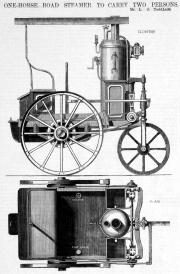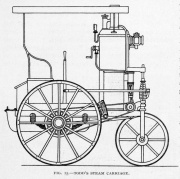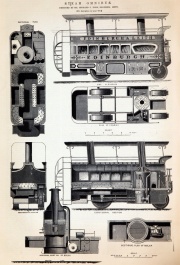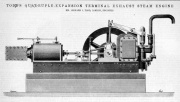Difference between revisions of "Leonard J. Todd"
| Line 1: | Line 1: | ||
[[image:Im1869EnV28-p414.jpg|thumb| 1869. One-horse road steamer.]] | [[image:Im1869EnV28-p414.jpg|thumb| 1869. One-horse road steamer.]] | ||
[[image:Im1899TETv2-p086.jpg |thumb| 1869. Todd's Steam Carriage. ]] | |||
[[Image:Im1872EnV34-p036.jpg|thumb| 1872. ]] | [[Image:Im1872EnV34-p036.jpg|thumb| 1872. ]] | ||
[[Image:Im1872EnV33-p222.jpg|thumb| 1872. ]] | [[Image:Im1872EnV33-p222.jpg|thumb| 1872. ]] | ||
| Line 12: | Line 13: | ||
1872 Steam Omnibus | 1872 Steam Omnibus | ||
---- | ---- | ||
Latest revision as of 14:15, 21 April 2015
Leonard J. Todd of Leith.
1871 Constructed a railway locomotive [1]
1872 Steam Omnibus
Extract from Steam Locomotion on Common Roads by William Fletcher. Published 1891.
In 1869, Mr. Todd, of Leith, made a neat little road locomotive mounted upon springs, having two steam cylinders, each 2.5 in. diameter and 4 in. stroke. The two driving wheels were 4 ft. diameter; the engine would run one hundred miles in ten hours.
Three years later Mr. Todd designed and constructed a special road locomotive to run mails and passengers at high speeds, in such places abroad where there were good main roads, between important stations not connected by railways. The engine was carried on two driving wheels, having springs, 6 ft. centres, and two leading wheels, each mounted upon volute springs. The steel springs were likewise supplemented by rubber washers, so that no trace of vibration remained. The boiler was of the locomotive multitubular type, intended for working at 180 lb. pressure. Two cylinders, 10 in. diameter and 10 in. stroke, were connected to the crankshaft in the usual manner: spur gearing having a ratio of four to one connected the crankshaft and a countershaft together, motion being transmitted from a disc on the countershaft to the main axle by side coupling rods.
Fisher's parallel rods were also used for connecting the axle boxes of the counter- shaft shaft and the main axle together. By this arrangement the axle can bear any amount of vertical play without the working spur gearing being at all affected. All the wheels had solid wood discs and iron tyres. The engine would, on a suitable highway, take a load not exceeding seven tons a distance of one hundred miles in ten hours.
Mr. Todd offers the following remarks respecting the rigid wheels: "It has been stated that it is impossible to run a rigid-wheeled engine twenty miles an hour on an ordinary macadamised road. The statement is simply not correct, for this has frequently been done. A rigid wheel carrying four tons, with a 50 in. bearing spring and rubber washers, runs with smoothness on macadam at twenty miles an hour ; and again, another rigid wheel also loaded with four tons, and fitted with two volutes and rubber washers, runs as smoothly at twenty miles an hour on a good road as an ordinary railway carriage. The fact is, rigid wheels have got a bad name as being rough to ride on, simply because they are almost universally used in road locomotives without any springs at all, or at best with springs so stiff as to almost prevent any motion of the axle; and thus the wheels are blamed for what is most obviously the fault of the designer."
In 1872, Mr. Todd constructed a steam omnibus for running between Leith and Edinburgh.
See Also
Sources of Information
- ↑ British Steam Locomotive Builders by James W. Lowe. Published in 1975. ISBN 0-905100-816









